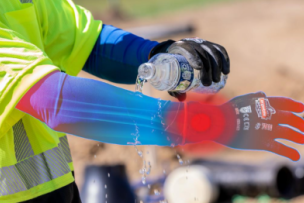Job one for employers is, of course, keeping workers safe. This involves revising office layouts, ensuring safe employee distancing and the frequent cleaning and disinfecting of everything that may harbor the coronavirus, from CNC machines to door handles.
Read more: First Aid: The Training and Supplies Your Company Needs
PPE is the last line of defense for those disinfecting a facility. But it’s not enough to simply purchase protective gowns, gloves and face masks. Employees should know the appropriate PPE to wear for each task and know how to don, doff and appropriately discard it.
Selecting the Appropriate PPE
DuPont SafeSPEC is an interactive tool that helps companies make informed decisions about PPE and other protective garments to use when cleaning a facility and handling various chemicals.
The site provides information about the company’s complete range of protective garments and accessories that address a broad range of PPE needs, including the Tyvek®, Tychem®, Kevlar® and Nomex® protection product brands.
Users can search for the appropriate protective garments by inputting various hazard scenarios to yield the best match for their task, from protective coveralls to glove and sleeve protection, helping to reduce contamination of workers’ skin and clothing by potentially infectious pathogens.
A user can enter from one to five chemicals or other hazards that may be present in a working environment, and the tool will find products that provide protection against the combined hazards.
The site allows users to search by hazard, industry or pre-saved scenarios or use a guide to find their particular chemical mixture or scenario. SafeSPEC even auto-fills complex chemical names to help users locate results quickly and easily.
For example, if a user were to submit disinfecting a room with a possible “bloodborne pathogen” as a hazard, that user may receive as a PPE suggestion a DuPont Tychem 4000 coverall, which features a standard fit hood, elastic wrists and attached socks. A “double-check” feature allows the user to tell if the product is suitable for a particular hazard (a chemical used for cleaning, for example), or a link to a “technical data sheet” that gives more detailed information about the product.
A user may also receive other PPE suggestions. DuPont Tychem nitrile gloves NT430, NT470and NT480 meet the EN ISO 374 standard for viral protection. They also provide over eight hours of protection against many common EPA-registered disinfectants, including bleach solutions, hydrogen peroxide and citric acid.
Assessing Your Workplace Risks
Before using the DuPont SafeSPEC tool, you’ll want to first identify the hazards you will face at your worksite and do a full risk assessment, which will include considerations such as workplace layout. Some workplace hazards may require more than one piece of PPE, such as working with a chemical like chlorine that irritates both the respiratory system and the eyes, requiring respiratory, skin and eye protection.










Talk to Us!
Send to me duits for work with hood and cover feets
55Leave a reply
Your email address will not be published. Required fields are marked *